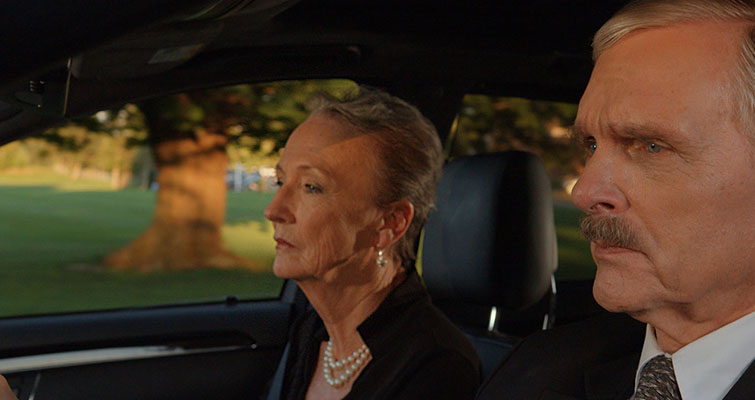
Grading Insights From Pro Colorist Patrick Inhofer
We sat down with pro colorist Patrick Inhofer to discuss his color grading process and how new colorists can jump into the color industry.
Top image: Sun Belt Express via IMDb
Last month we interviewed prolific author and colorist Alexis van Hurkman about his vantage point of the industry. We’ve got another exclusive, this time with colorist Patrick Inhofer, a 25-year veteran of the post community. His long list of clients include HBO, NBC, ABC, Showtime, and ESPN. His foray into teaching began in 2005, and Inhofer has since has made coaching a key part of his business with his sites Tao of Color, Colorist Flight School, and Mixing Light.
Here’s Inhofer’s showreel:
From Editing to Coloring
Inhofer went to school for television and film, working as an editor for about a decade in large Manhattan edit houses before making the switch to freelance. That’s how he found color grading.
When it came time for me to go freelance and start selling my services, I realized super quick that many of my competitors didn’t know what a good-looking picture looked like. They didn’t even know how to read a scope, which I learned in college. I decided to establish myself as someone who had this additional skillset. As software became more capable of digital color correction, I realized I loved it, and I made a conscious transition towards full-time color correction.
Having a color grading subspecialty benefitted Inhofer, and today continues to differentiate many of the editors he coaches.
I teach a lot of editors who are well served by not only being good at editing and putting a story together, but by having a subspecialty they can sell their clients on. Color correction is a great skill to have. It has a visual impact on the image. You can do a before and after and really see the difference. For a lot of the people I coach, color correction won’t be their primary job, but it allows them to differentiate themselves from their competition. I’m a big proponent for that.

Screencap from Rivers Wash Over Me
Five years ago, Inhofer started Tao of Color, a weekly colorist-focused newsletter, which in itself was a part-time job, taking up 20-25 hours a week.
Tao was designed as a community-building exercise when there was very little cohesive communication going on about color grading. That was a way of pulling together everything that was happening in the community.
With this split revenue system, I wondered about the balance of business in traditional coloring versus coaching.
It’s about 50-50 right now. I’d like for a bit more to come out of training. When you’re selling product, if you’re not constantly generating new product, any good will you’ve built up starts to evaporate. To go down that route, there’s a certain amount you have to commit to, and I haven’t found the right amount that allows me to run Mixing Light and Tao of Color.
For many of us that wear multiple hats, finding the right mix to devote time to each aspect of our business can clearly be challenging.
My goal is to cut back on grading about 15 percent, maintaining a smaller base of regular clients. That’ll free up time to revitalize Colorist Flight School, where I’ll be offering certifications. I need to keep the client base to keep me relevant on software, workflows, and changes in the industry, and the training allows me to live a more independent lifestyle that isn’t tied to any particular region.
Approach and Philosophy to Color
 Screencap from The Mlabri People and Yellow Leaf Hammocks
Screencap from The Mlabri People and Yellow Leaf Hammocks
Inhofer’s color career focuses on narrative feature, short film, and documentary forms. When teaching, he makes a distinction between training and coaching.
I’m completely uninterested in teaching you how to push the buttons, but you need to know how the software works in order to execute what I consider the more interesting stuff. All of my training involves a degree of button pushing, but what’s really emphasized is craft, workflow, image analysis, and client communication. The Resolve 12 training series that just came out is fourteen hours long, but a good portion of that is spent teaching you how to use scopes, how to communicate with clients, and understanding colorist lingo, so you can communicate with people in the field.
Having purchased some of Inhofer’s titles when I was starting out myself, it’s clear he finds it important to walk away with an understanding of the software but also the various workflow approaches that inform how a colorist thinks. A colorist shouldn’t always be grading the same way each time, as projects require different sensibilities and invariably contain different issues. I asked him if he had a general approach when attacking a project.
Maybe the exact tool you’ll pull up for a project may vary, but I think of things in a multi-pass workflow. All colorists work in a very particular order, it’s just when you get to a certain level of craftsmanship, it’ll all start to meld together. The three-pass workflow is especially good for, say, editors short on time. If you’re coloring a twenty-minute program, the worst thing that can happen is that you make the first ten minutes look awesome and the last ten looking like crud. I wouldn’t consider that acceptable. I’d much rather have a nice even show that maybe doesn’t have all the awesome elements, but at least every shot got touched. The three-pass workflow allows you to get done all the really important stuff first, to then add another layer of finesse before circling back again to execute the final look.
This multi-pass workflow addresses aspects of the image in a specific order, so that a budding colorist doesn’t get tripped up by performing a stylized look on the image too early in the process.
When people think of color grading they think about look creation. On Mixing Light, those threads always get the most comments. That’s what everyone loves to do, but look creation can become a nightmare very, very quickly when you’re doing not just one shot, but an entire scene. Jumping straight to the crazy look is about the worst thing you can do.

Screencap from Isn’t It Delicious
Inhofer’s multi-pass workflow corrects each shot’s problems, regardless of its context. This involves setting the proper black and white points as well as achieving good color balance and saturation for an overall feeling of balance in the image. This initial stage should not absorb too much time.
Then you can circle back and handle your shot matching. When you’ve done all that, then when you add your look filter, all of the images already match, so whatever your filter does, all the images will generally react the same way to it. You may find that you need to go back and tweak certain shots, but you’re not having to redo all your color correction like you would if you’re diving into the look before doing the prep work ahead of time. That’s really the core of my teaching.
It’s very easy for beginners to get lost in working on a single shot for five or ten minutes. With too many layers, it may become tough to match to other shots afterwards. Plus, what if your client comes in after all that work and doesn’t like the direction? You’re back at square one. That’s why in the beginning, it’s crucial to take a global view of the entire project.
Another thing I try to teach is knowing when to stop using the scopes and start using your eyes to make judgement calls. There’s a point in the workflow where you stop using the scopes, and it becomes more about whether it feels right or wrong.
Color grading is highly technical, but it is also an art form. Here Inhofer is speaking about breaking away from the ones and zeroes and relying on our aesthetic tastes. If the images create a perceptual match, and both you and the client think it looks good, you’ve done your job.
Watch Inhofer’s Color Grading Breakdown Reel here
Working With Clients
 Screencap from Lilith
Screencap from Lilith
On the flip side of this, Inhofer next warns against clients who are too technical.
When a client starts telling me what move to make, that’s when I get worried, because that’s when I start chasing after them. To prevent this, I ask how a particular grade makes them feel or what they feel is wrong with the image. When they tell me to put warmth in the midtones, I ask, ‘what are we trying to fix?’ It’s more important that I figure out what is motivating the direction over executing that direction. Sometimes their comments make you take the wrong move.
This is especially true of directors of photography that sit in during a session. DPs use technical terms when talk about feelings or perceptions are easier to determine which moves a colorist could make.
There may be multiple possible moves, whereas if the DP tells you to ‘take the mids down,’ you only have one choice for what to do. It becomes a lot more limiting. That said, I’ve learned to communicate with clients through talking with DPs. Good DPs know their craft, and you’re an extension of their work, but it’s not a one-to-one extension, and they often have trouble understanding that. Where I get into trouble the most with DPs is when I just do the move they ask for without finding a motivation behind it. That usually leads to a very frustrating color correction session until I find out what they’re reacting to. Once you start opening up the discussion, then all of a sudden they start to relax because they don’t have to think through it. Now they can just tell you what they’re seeing, and it’s your job to turn that into specific moves. Early on with new DPs that I’m working with, I try to get into that discussion. Then when they can see that I can more quickly solve that problem, they ask what I did and I’ll tell them, but then they’ll back off. They learn to trust you.
DPs are used to talking about stuff like lenses and gamma from being on set. Talking about ISO is just the world they know, so it’s natural for them to bring that lingo into session. Colorists must assert their value in session by showing they’re more than just button-pushers. I asked Inhofer if the toughest part of his job was navigating a new client and seeing where their eyes were.
For an experienced colorist, the toughest, most important part of the job, I call ‘seeing through the client’s eyes,’ understanding what they’re seeing and what their eyes like and don’t like. What’s the right amount of skin tone? What’s the right color of the blue sky, the green lawn? Do they like it overall brighter or darker? Do they want more pools of light or less? Do they like vignetting? You want to establish that really early. If you discover what they like too late in the process, you’re going to go back and redo your work.
 Grace via IMDb
Grace via IMDb
Another part of Inhofer’s workflow and teaching method is the hero shot workflow.
Select a small subset of your shots and work on those with your client and get them in front of the client who can say ‘no.’ Often the client who walks in is not the person who can force you to redo the whole job. You want to reach the person who, if they don’t like it, the job is getting redone. You want to get them involved as early as possible, and sometimes you can only get those people for two or three hours.
Two or three hours would be a luxury. Mine usually fly by for ten minutes to see how the session’s going.
Right, maybe they only have an hour to review and send notes. So that’s why I use this hero shots workflow where you pull representative shots to work on and learn what those clients like. Pull the best and worst looking shots, some important shots, and work on about 15 or 20 shots [for a long-form project] with the client, quickly establishing key looks, to learn how to look through their eyes.
That first ten minutes with a new client can give me performance anxiety. I run a smaller shop just like Inhofer, and in my mind, the client’s wondering why they aren’t going with a different shop. Anyone’s work is still judged from high standards, and the first ten minutes is crucial to establish credibility.
The first ten minutes are about workflow confidence, building rapport and letting the client know you know what you’re doing. If you look like you’ve done this before and you have an approach, even if they scrap it, well at least they know you have a way of working. Imagine an editor who didn’t pull selects to assemble a rough cut down to the fine cut.
That editor wouldn’t get very far. A key part of my workflow is getting the drive the night before so I can load everything to make sure it’s ready to go. Occasionally I’ll get issues with the conform that can take time to solve, and I hate to work through technical issues when the client is ready to get creative.
I totally agree. Anything you can do to prep the job beforehand, the happier the client will be. Every now and again you’ll have a client who just isn’t ready, where the edit is still being tweaked.
I must get that every week.
The important thing is to manage their expectations so they know what they’re walking into and aren’t surprised. You may have to tell them they’re going to be checking their email while their piece gets conformed.
Future Tech
 Screencap from Dead Man’s Lake
Screencap from Dead Man’s Lake
It’s great to have a client that can sign off on a grade when they’re in the same room with you, but more clients prefer working remotely. I asked Inhofer to comment on the issue of evaluating work on displays that appear different than calibrated monitors.
There are client directions you’re going to get that are just wrong. When client notes come in that are less technical and more instinctual and creative, I don’t worry about it. I’ll make the adjustment as long as it still looks good to me. If I look at things on the reference display and their instructions are clearly going to make things worse [due to how they’re evaluating the picture], that’s when we’ve got a problem. One way I get around it is to ask if they have an iPad 3, which more than likely is going to be way more accurate than just about any other device.
Hopefully we won’t be dealing with this problem in a few years when displays are calibrated to rigorous standards.
I think High Dynamic Range (HDR) is going to go a long way towards solving this problem because manufacturers are starting to think about the problem of interoperability of images. It may take a while, but HDR will give us the first opportunity to lock our images down. There’s always going to be problems with monitors as they age and drift. I call this the problem with grandma’s blue TV: should I color correct for grandma’s antiquated blue TV? Well, no. Your uncle might have a red TV. If colorists are grading to a common standard, and that’s our target, now when you watch my television show next to your spot, they look consistent. Our eyes will adjust to whatever the display is doing. If all of our programs run together, they’re consistently in the same place. If I try to adapt to a monitor that isn’t to spec, then you’re going to get stuff that is all over the place.
At places like sports bars, where displays are everywhere, I tend to wonder what the picture’s actually supposed to look like. Every monitor is tuned differently, but which one shows what the colorist intended? It drives me crazy.
This isn’t just our TVs. This is rampant in theatrical presentation. You would think movie theaters, whose product is a high-quality image, care about this stuff, but they don’t. They’ll put their lightbulbs at half power just to double the life of the bulb. It obviously muddies up the image. The entire exhibition industry seems to have no regard for the quality of our images, which I don’t understand.
HDR is one of the places tech is heading, but are there any other sectors to watch? Where did Inhofer see the industry heading in the next 5-10 years?
I’m not very good with this. I couldn’t have predicted HDR two years ago, but I’ve seen HDR that looks three-dimensional. The contrast is so poppy that that extra contrast in the image, it doesn’t look like video. It looks real. I don’t need 3D glasses with that, but if you give me that plus 3D without the glasses, it’ll be almost like VR. HDR is where to watch right now, and it’s happening quickly. A lot of people have been skeptical because the broadcast networks won’t be adopting it, but with so many streaming services available who will, the networks will be left scrambling.
4k is great for acquisition, but it’s irrelevant for distribution. It’s great for outdoor displays and theatrical, but if you’re delivering to YouTube or a home television set, 4k is ridiculous. HDR, on the other hand, is awesome, whether it’s traditional HD or UHD. You really get the bang for the buck. 4k is overhyped from a consumer standpoint. From a colorist’s perspective HDR will bring wider color gamut, which means more and richer colors to work with.
The other thing I think is really interesting is VR. I’m actively looking for opportunities to start color grading some of that stuff, to see how the workflow works.

Tanzania: A Journey Within via IMDb
Aside from tech, where does Inhofer see the color grading profession going? Maybe it will become even more ubiquitous like audio and offline editing have been.
If it doesn’t, I’ll have failed in my mission to rid the world of unintentionally ugly images (laughs). The tools are already there and the awareness of color correction is exploding, for good reason: it makes a visible impact on the quality and messaging of the work that we do.
Color’s an enhancement of the DP and editor’s work. It has as much value as an audio mix does. That’s already been proven, and the tools are already there. You can do a great job color correcting in Final Cut X or Premiere Pro CC 2015’s Lumetri Color Panel. You’ve got SpeedGrade, and Avid Symphony has been around for a decade and a half. The tools are there, it’s more a matter of loosening the intimidation. When people first start coloring, they move sliders without an approach, and when they don’t know what to do, they feel untalented, so they’re going to avoid it. The things I teach are designed to help people feel talented. I feel like the future for the craft is very bright.
The tone changed when Inhofer discussed the actual artists of the work.
For the practitioners, it depends. You’re going to have dislocations. You can’t go from exclusive suites with million dollar black boxes to software that’s on every laptop and not have some professional dislocation happen. That doesn’t make it bad, it just makes it different. Does it get rid of those million dollar black boxes? No, but it takes some of the work that was at the margin, that could barely afford those jobs, elsewhere. So it definitely impacts the high end, because those marginal cases go away.
But, consider how many days of video get uploaded to Youtube every day. A lot of that isn’t cat videos. A lot is corporate messaging, and all of that needs professional color work, whether it’s done by a full-time colorist or an editor doing color correction. That’s where the tension in the industry is right now. Probably the most difficult profession in post-production is the full-time colorist in the sense that our jobs are so short. The calendar is a hungry, hungry beast, and you have to keep feeding it. A full-time on-set DIT can get booked for thirty days. A full-time colorist sitting in a room, the longest job will last, maybe two weeks? And that might be an exception. You might get only one of those a year.
I can attest to that. Most of my jobs are a day or less, often just a few hours, since I primarily grade short-form commercial and corporate work.
That is a hungry, hungry beast. The frustration that a lot of solo colorists feel is not a function of there not being enough work out there, because there is, it’s that you need someone else to hunt it full-time so that you can be doing your craft. That’s the challenge, and if you don’t understand that you will be very disappointed being a full-time colorist. You’re going to have lots of busy peaks, and then lots of valleys when you don’t have any work coming in. To solve this I coach, but I’ve been in this business for 25 years. I have nothing to prove any more, and I’m happy to give up some of my color work in order to spend more time on teaching other people how to do it.
Further Wisdom
 Screencap from An Affair of the Heart
Screencap from An Affair of the Heart
For those of you looking for even more insight, Inhofer has a forthcoming book on more of his teaching philosophy titled The Color Correction Coach coming out this spring.
It’s going to go through essentially the fundamentals of color correction, the initial primary correction and shot matching, with a second section about look creation. The third part will be about client communication and running a business. The business has changed, and more of us are operating in small teams or as solo artists, and there are challenges there that are different than if you work in a big post house where you have support staff and sales reps.
The book is pretty application agnostic. I’m teaching concepts, not software. This book will definitely not be a technical book, in fact I’m ripping out all of the stuff on how to read scopes and the mumbo-jumbo most color correction books get swamped in, stuff like talking about 8-bit versus 10-bit. This is a workflow book, a coaching book.
In closing, Inhofer had some advice for people just starting out in color correction.
There’s never been a better time to be a filmmaker or someone who supports filmmaking. You just need to have a story and some people who are even half-talented at telling those stories to find work. When I look at the resources available to college kids, I tell them they should be making four, five, six short films a year! There should be non-stop production going on. The way you gain experience is by gaining experience. I can point out the mistakes to avoid and point out some tips and tricks. I can shorten your launch, but in the end you need to do it to get good at it. Hook up with people who are creating these things. If you see something on YouTube you really like but it looks like crud, contact them and ask for the source footage. If you’re literally at the beginning rung, you just need to touch video from other people. Just touch images all the time.
How has Patrick Inhofer helped you on your motion graphic journey? Share in the comments below.





